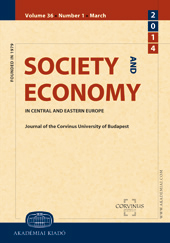EU funds in EU new member states: Available resources and possible economic impact
EU funds in EU new member states: Available resources and possible economic impact
Author(s): Robert SierhejSubject(s): Economy, Economic development, EU-Accession / EU-DEvelopment
Published by: Akadémiai Kiadó
Keywords: EU funds; new member states; economic growth; economic models;
Summary/Abstract: EU funds have been an important component of economic landscapes in the new member states (NMS) after their EU accession in 2004. A review of funds allocated to NMS under the 2007–2013 financial perspective shows a substantial growth in nominal terms. The increase relative to the GDP of the beneficiary countries is much more modest. This implies that the economic impact could be less spectacular than expected. From this viewpoint, it is crucial to ensure high absorption and efficient allocation of Structural Funds which are gaining importance in total transfers. Different frameworks established by NMS to manage EU funds show that there is no one-fits-all model. Experiences with absorption of Structural Funds in NMS have been mixed, with no conclusive evidence for superiority of any particular approach. NMS tend to streamline their initial frameworks to improve absorption, a reasonable approach to help utilise the increasing 2007–2013 allocations. At the end of the day, the goal of EU transfers is increasing growth potential. This dimension could be captured by economic models. While they are useful analytical tools, the results could differ a lot and should be taken with a grain of salt given the problems of model specification and calibration for NMS. Finally, the experience of old member states shows that high inflows of EU funds could not substitute, but only complement, good economic policies.
Journal: Society and Economy. In Central and Eastern Europe ǀ Journal of the Corvinus University of Budapest
- Issue Year: 30/2008
- Issue No: 2
- Page Range: 181-193
- Page Count: 13
- Language: English

